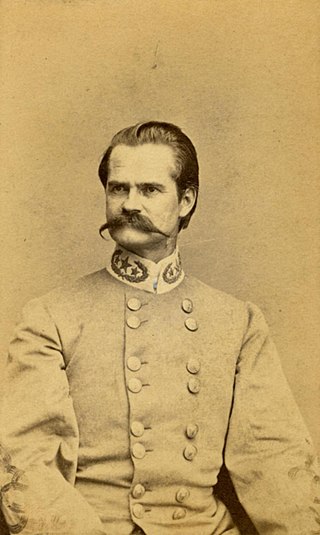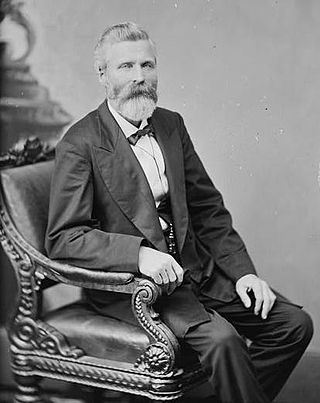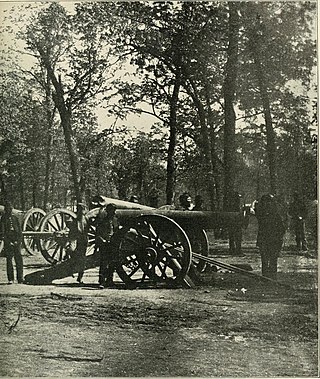
William Nelson Rector Beall was a brigadier general in the Confederate States Army during the American Civil War. He is most noted for his supply efforts on behalf of Confederate prisoners of war.
The 17th Wisconsin Infantry Regiment was an infantry regiment that served in the Union Army during the American Civil War. It was popularly known as the Irish Brigade, due to its composition of mostly Irish American immigrants.
The 30th Regiment Illinois Volunteer Infantry was an infantry regiment that served in the Union Army during the American Civil War.
The 5th Ohio Cavalry Regiment was a regiment of Union cavalry raised in seven counties in southwestern Ohio for service during the American Civil War. It primarily served in the Western Theater in several major campaigns of the Army of the Tennessee.
The 6th Kentucky Cavalry Regiment was a cavalry regiment that served in the Union Army during the American Civil War.
The 7th Kansas Cavalry Regiment was a cavalry regiment that served in the Union Army during the American Civil War.
The 3d Arkansas Cavalry Regiment (1861–1865) was a Confederate Army Cavalry regiment during the American Civil War.
The Jeff. Davis Legion was a cavalry regiment of the Confederate States Army. Made up of companies from Mississippi, Alabama, and Georgia; it fought primarily in the Eastern Theater of the American Civil War. In 1865, it was reassigned to the Army of Tennessee, surrendering at Greensboro, N.C.

The 2nd Arkansas Cavalry Regiment (Slemons') (1861–1865) was a Confederate Army cavalry regiment during the American Civil War. This regiment was also referred to in the official records as the 4th Arkansas Cavalry Regiment. Another regiment, commanded by Colonel Thomas J. Morgan, was also designated as the 2nd Arkansas Cavalry Regiment. Following Price's Raid in 1864, the survivors of the regiment were reorganized as the 18th Arkansas Cavalry Battalion, which was also referred to as McMurtrey's Arkansas Cavalry Battalion.
The 3rd Arkansas Light Artillery, also known as the Jackson Light Artillery (1861–1865), was a Confederate Army artillery battery during the American Civil War. The battery spent the majority of the war serving in Confederate forces east of the Mississippi River. The battery is also known as McCown's Battery, Hubbard's Battery, and Thrall's Battery in official reports.

The 1st Florida Infantry Regiment was an infantry regiment raised by the Confederate state of Florida during the American Civil War. Raised for 12 months of service its remaining veterans served in the 1st (McDonell's) Battalion, Florida Infantry from April 1862 on. In August the depleted battalion was consolidated with the 3rd (Miller's) Battalion into the reorganized 1st Florida Infantry Regiment again. In December 1862 it merged with the 3rd Florida Infantry Regiment and received the form it kept till the war's end as the 1st and 3rd Consolidated Florida Infantry Regiment. Fighting as part of the Army of Tennessee in the Western Theater of the American Civil War it was surrendered on April 26, 1865.
The 1st Arkansas Cavalry Battalion (Stirman's) (1864-1865) was a Confederate Army cavalry battalion during the American Civil War. The unit was also known as Brooks 1st Arkansas Cavalry Battalion, Stirman's, 1st Arkansas Cavalry Battalion, Stirman's Sharpshooter Regiment, 1st Regiment Arkansas Sharpshooters, and finally simply as Stirman's Arkansas Cavalry Regiment.
The action at Abraham's Creek was an engagement on September 13, 1864 between Union Army and Confederate States Army forces during a Union reconnaissance in force toward Winchester, Virginia. The action occurred during skirmishing, maneuvering and scouting before the Third Battle of Winchester on September 19, 1864 in the Valley Campaigns of 1864 during the American Civil War. The Union force successfully completed the mission and captured about 173 Confederate prisoners.

The 1st Missouri Volunteer Cavalry Regiment was a cavalry regiment with three battalions that served in the Union Army during the American Civil War from 1861 to 1865.

The 1st Missouri Cavalry Regiment was a cavalry regiment that served in the Confederate States Army during the American Civil War.
The 61st United States Colored Infantry was an infantry regiment that served in the Union Army during the American Civil War. The regiment was composed of African American enlisted men commanded by white officers and was authorized by the Bureau of Colored Troops which was created by the United States War Department on May 22, 1863. The non-commissioned officers (sergeants and corporals) and enlisted men were African Americans. The regiment was originally organized as the 2nd Tennessee Volunteer Infantry (African Descent) and was also referred to as the 2nd West Tennessee Infantry Regiment (African Descent).

The 9th Texas Cavalry Regiment was a unit of mounted volunteers that fought in the Confederate States Army during the American Civil War. The regiment fought at Round Mountain and Bird Creek (Chusto-Talasah) in 1861, Pea Ridge, Siege of Corinth, Second Corinth, Hatchie's Bridge and the Holly Springs Raid in 1862, and in the Atlanta campaign, Franklin, and Murfreesboro in 1864. The unit fought dismounted at Second Corinth and Hatchie's Bridge before being remounted as cavalry for the remainder of the war. The regiment surrendered to Federal forces on 4 May 1865 and its remaining personnel were paroled.

The 27th Texas Cavalry Regiment, at times also known as Whitfield's Legion or 1st Texas Legion or 4th Texas Cavalry Battalion, was a unit of mounted volunteers that fought in the Confederate States Army during the American Civil War. First organized as the 4th Texas Cavalry Battalion or Whitfield's Legion, the unit served dismounted at Pea Ridge and First Corinth. Additional companies from Texas were added and the unit was upgraded to the 27th Texas Cavalry Regiment or 1st Texas Legion later in 1862. Still dismounted, the unit fought at Iuka and Second Corinth. The regiment was remounted and fought at Holly Springs in 1862, Thompson's Station in 1863, and at Yazoo City, Atlanta, Franklin, and Third Murfreesboro in 1864. The regiment surrendered to Federal forces in May 1865 and its remaining soldiers were paroled.

Battery B, 2nd Illinois Light Artillery Regiment was an artillery battery from Illinois that served in the Union Army during the American Civil War. The battery was organized in June 1861. It fought at Shiloh, First Corinth, and Second Corinth in 1862. Subsequently, the unit garrisoned Corinth, Mississippi until January 1864. It was stationed at Memphis, Tennessee until June 1864 when it fought at Brices Cross Roads. The battery garrisoned Memphis until it was mustered out in July 1865.

John Gordon Coltart was a Confederate States Army officer who held regiment, brigade and division command during the American Civil War.









